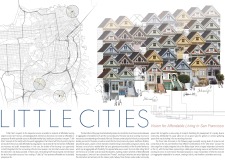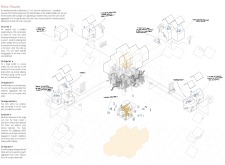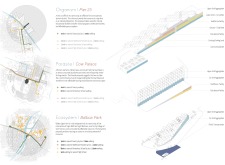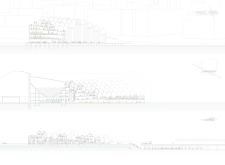5 key facts about this project
This project represents a melding of innovative architectural ideas with practical living solutions. By creating micro-communities, "Little Cities" not only provides housing but also establishes a sense of belonging among the residents. Each unit within this architectural design has been tailored to accommodate various demographics, fostering social interaction and community ties.
The project features several types of residential units, including compact single units for individuals, cozy units for couples and small families, and larger units designed for multigenerational households. This range of unit types ensures that the design meets the diverse needs of the urban population, while maintaining a balance between privacy and communal living spaces. The incorporation of multifunctional spaces allows for flexibility in use, which enhances the livability of every housing unit.
One of the defining features of "Little Cities" is its integration with the surrounding urban context. The design encourages easy access to public transportation, reinforcing the connection between the housing units and essential services such as healthcare, education, and local commerce. This thoughtful positioning not only enhances convenience for residents but also promotes sustainability through reduced vehicle dependency.
The materials used in the construction of the project—primarily wood, masonry, metal, and glass—further contribute to its unique character. The use of wood gives warmth and echoes the historic architectural styles prevalent in San Francisco, while masonry ensures robustness and longevity. Metal elements, particularly in roofing and detailing, provide a modern touch, contrasting with the warmth of the wooden facades. Large glass windows and entryways allow natural light to penetrate deeply into the living spaces, reinforcing the importance of a bright and airy environment.
Moreover, the project design incorporates community-centric features that reflect a commitment to creating spaces conducive to social interaction. Common areas and facilities, such as shared gardens and recreational spaces, serve to connect residents, enhancing their sense of community. These design choices not only address housing needs but also prioritize well-being and quality of life.
The architectural approach of "Little Cities" stands out for its emphasis on sustainability and ecological responsibility. Elements such as green roofs, rainwater collection systems, and energy-efficient designs are seamlessly woven into the project's fabric. This approach promotes an environmentally friendly lifestyle for residents, contributing to a healthier urban ecosystem.
In summary, "Little Cities" offers a comprehensive solution to the challenges of urban housing in San Francisco. With its emphasis on community engagement, diverse living options, and sustainable practices, this architectural project exemplifies a forward-thinking approach to modern living. For those interested in exploring the intricate details of this project, including architectural plans, sections, and various design ideas, reviewing the project presentation will provide deeper insights into this innovative endeavor.


























